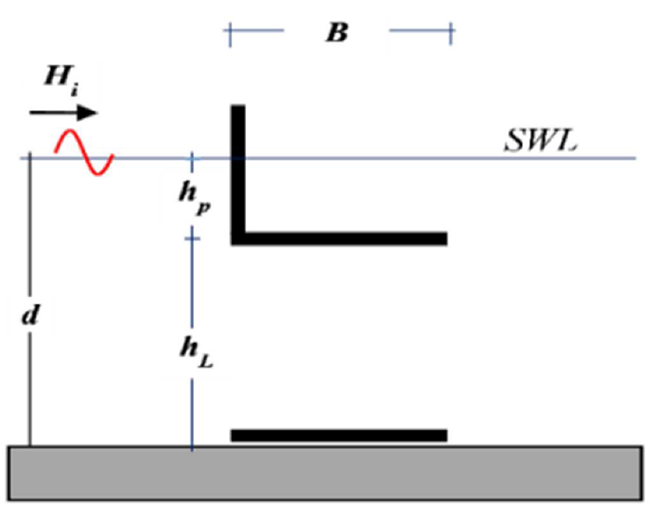Wave Transmission and Energy Dissipation in a Box Culvert-Type Slotted Breakwater
DOI:
https://doi.org/10.46604/aiti.2022.9080Keywords:
breakwater, box culvert, wave transmission, energy dissipationAbstract
This research is conducted to examine the transmission wave and energy dissipation of a box culvert-type slotted breakwater, which is designed as a breakwater structure with a watertight wall at the top and a box culvert type hole at the bottom. The process involves physical modeling of this structure in the laboratory. The hole and wave parameters are varied to determine the breakwater performance. The results show that the transmission coefficient (KT) value is reduced as the relative hole height (hL/d) value is decreasing and the relative hole length (B/L) and wave steepness (H/L) values are increasing. The energy dissipation coefficient (KD) value increases with an increment in hL/d, H/L, and B/L but starts to decrease after reaching the maximum, which is the optimum H × B/L2 value. This optimum value is found to be 0.0034(hL/d)2.618 depending on the (hL/d) value, while the maximum KD value is recorded to be 0.70.
References
O. S. Rageh, et al., “The Use of Vertical Walls with Horizontal Slots as Breakwaters,” 13th International Water Technology Conference, pp. 1689-1710, March 2009.
K. D. Suh, et al., “Wave Reflection from Partially Perforated-Wall Caisson Breakwater,” Ocean Engineering, vol. 33, no. 2, pp. 264-280, February 2006.
K. D. Suh, et al., “Wave Reflection and Transmission by Curtainwall-Pile Breakwaters Using Circular Piles,” Ocean Engineering, vol. 34, no. 14-15, pp. 2100-2106, October 2007.
K. D. Suh, et al., “An Empirical Formula for Friction Coefficient of a Perforated Wall with Vertical Slits,” Coastal Engineering, vol. 58, no. 1, pp. 85-93, January 2011.
A. S. Koraim, “Hydraulic Characteristics of Pile-Supported L-Shaped Bars Used as a Screen Breakwater,” Ocean Engineering, vol. 83, pp. 36-51, June 2014.
L. T. Somervell, et al., “Estimation of Friction Coefficient for Double Walled Permeable Vertical Breakwater,” Ocean Engineering, vol. 156, pp. 25-37, May 2018.
Z. Huang, et al., “Hydraulic Performance and Wave Loadings of Perforated/Slotted Coastal Structures: A Review,” Ocean Engineering, vol. 38, no. 10, pp. 1031-1053, June 2011.
N. Nurisman, “Efektivitas Submerged Breakwater Berlubang terhadap Gelombang Datang,” Jurnal Maritim Indonesia, vol. 7, no. 2, pp. 165-175, December 2019. (In Indonesian)
H. Ahmed, “Wave Interaction with Vertical Slotted Walls as a Permeable Breakwater,” Ph.D. dissertation, Department of Civil Engineering, Bergischen Universität Wuppertal, Germany, Wuppertal, 2011.
O. S. Rageh, et al., “Hydraulic Performance of Vertical Walls with Horizontal Slots Used as Breakwater,” Coastal Engineering, vol. 57, no. 8, pp. 745-756, August 2010.
A. George, et al., “Hydrodynamic Performance of a Vertical Slotted Breakwater,” International Journal of Naval Architecture and Ocean Engineering, vol. 12, pp. 468-478, December 2020.
G. Jarlan, “A Perforated Vertical Wall Breakwater,” The Dock and Harbour Authority, vol. 41, no. 486, pp. 394-398, 1961.
E. Mackay, et al., “Comparison of Analytical and Numerical Solutions for Wave Interaction with a Vertical Porous Barrier,” Ocean Engineering, vol. 199, Article no. 107032, March 2020.
K. G. Vijay, et al., “Wave Interaction with Multiple Slotted Barriers inside Harbour: Physical and Numerical Modelling,” Ocean Engineering, vol. 193, Article no. 106623, December 2019.
M. R. Nikoo, et al., “Multi-Objective Optimum Design of Double-Layer Perforated-Wall Breakwaters: Application of NSGA-II and Bargaining Models,” Applied Ocean Research, vol. 47, pp. 47-52, August 2014.
H. Ahmed, et al., “Numerical Investigation of Wave Interaction with Double Vertical Slotted Walls,” International Journal of Environmental, Ecological, Geological, and Mining Engineering, vol. 8, no. 8, pp. 536-543, April 2014.
H. A. K. S. Ariyarathne, “Efficiency of Perforated Breakwater and Associated Energy Dissipation,” Master thesis, Department of Civil Engineering, Texas A&M University, Texas, 2017.
N. Yuwono, Perencanaan Model Skala Hidraulis, Yogyakarta: PT Kanisius, 2021. (In Indonesian)
R. G. Dean, et al., Water Wave Mechanics for Engineers and Scientists, New Jersey: World Scientific Publishing, 1991.
J. S. Mani, “Design of Y-Frame Floating Breakwater,” Journal of Waterway, Port, Coastal, and Ocean Engineering, vol. 117, no. 2, pp. 105-119, March 1991.
K. Murani, et al., “Performance of Cage Floating Breakwater,” Journal of Waterway, Port, Coastal, and Ocean Engineering, vol. 123, no. 4, pp.172-179, July 1997.
A. S. Koraim, “The Hydrodynamic Characteristics of Slotted Breakwaters under Regular Waves,” Journal of Marine Science and Technology, vol. 16, pp. 331-342, May 2011.
A. S. Koraim, “Mathematical Study for Analyzing Caisson Breakwater Supported by Two Rows of Piles,” Ocean Engineering, vol. 104, pp. 89-106, August 2015.
B. M. Webb, et al., “Wave Transmission through Artificial Reef Breakwaters,” Coastal Structures and Solutions to Coastal Disasters Joint Conference, pp. 432-441, September 2015.

Published
How to Cite
Issue
Section
License
Submission of a manuscript implies: that the work described has not been published before that it is not under consideration for publication elsewhere; that if and when the manuscript is accepted for publication. Authors can retain copyright in their articles with no restrictions. is accepted for publication. Authors can retain copyright of their article with no restrictions.
Since Jan. 01, 2019, AITI will publish new articles with Creative Commons Attribution Non-Commercial License, under The Creative Commons Attribution Non-Commercial 4.0 International (CC BY-NC 4.0) License.
The Creative Commons Attribution Non-Commercial (CC-BY-NC) License permits use, distribution and reproduction in any medium, provided the original work is properly cited and is not used for commercial purposes.







